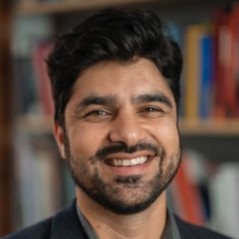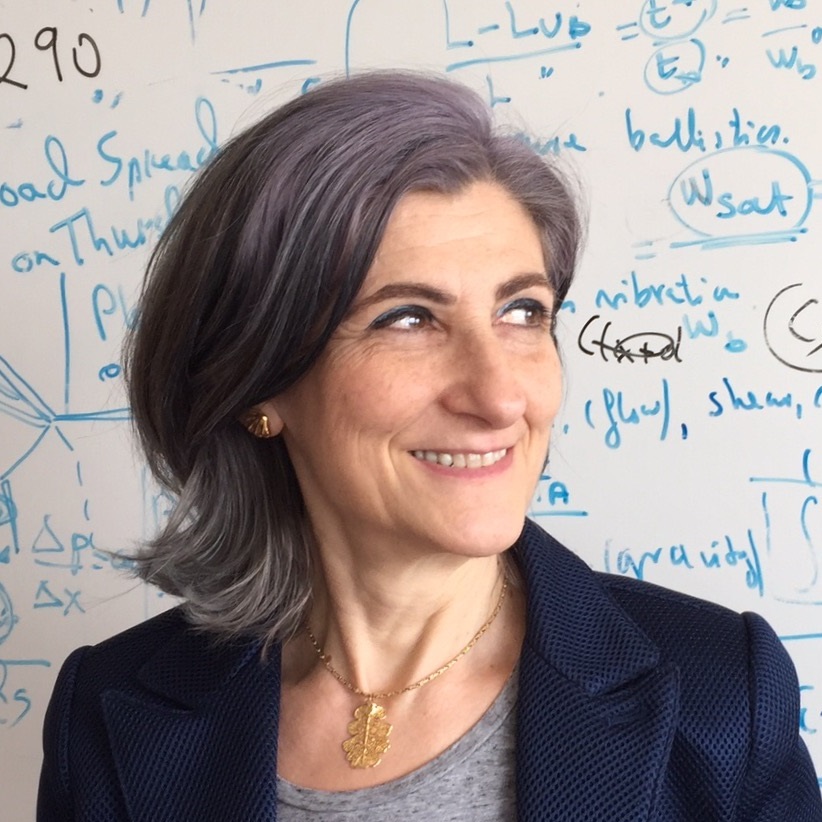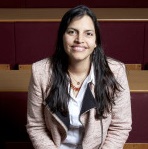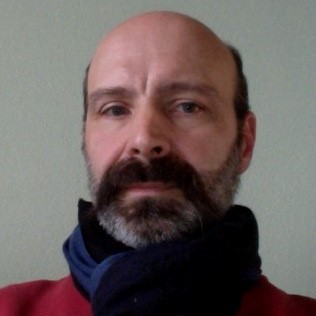 |
Shervin Bagheri
KTH Royal Institute of Technology, Sweden
|
|
Title:
Stability and functionality of immobilised liquid-liquid interfaces in periodic structured media
Abstract:
In this talk, I will discuss how liquid-liquid interfaces can be stably locked into periodic structured porous substrates and used for controlling the transfer of momentum, heat and mass with an external flow. First, we address the behavior of liquid-liquid interfaces locked in textured surfaces and exposed to an external shear flow. When the liquid-liquid interface remains stable, these surfaces can enhance heat and mass exchange with a bulk flow and reduce flow drag and biofouling. We demonstrate how shear stresses and soluble surfactants modify the dynamics of the liquid-liquid interface, resulting in waves, drainage and Marangoni stresses, all of which significantly affect transport processes with the external flow. Second, we introduce systems with liquid-liquid interfaces locked in three-dimensional periodic porous scaffolds. By tuning the wettablity and introducing appropriate “fluid traps”, we can immobilize interfaces of different morphologies, including spherical droplets or diamond-shaped structures. These multi-phase materials are remarkably stable and provide a very high area-to-volume ratio. We will discuss their potential as flow-continuous heterogeneous catalysis and for other applications that require optimizing mass transfer across interfaces, such as CO2 capture.
Bio:
Professor Bagheri’s research focuses on the interaction between flowing fluids and complex materials across different length and time scales, ranging from molecular aspects of triple-phase contact lines to turbulent flows of porous media. His main objective is to apply this understanding to design new surfaces and materials to control/sense flows and particles suspended in fluids. Shervin Bagheri graduated in Fluid Mechanics at Royal Institute of Technology (KTH) in Stockholm in 2010. In 2017, he was appointed as Wallenberg Academy Fellow and received the Future Research Leader award by Swedish Foundation for Strategic research (SSF). Since 2020, he is a member of the Young Academy of Sweden.
|
| |
 |
Bruce Balcom
University of New Brunswick, Canada
|
|
Title:
Magnetic Resonance Measurements of Fluids in Shale
Abstract:
Shale formations are of increasing importance world-wide as petroleum reservoirs. Conventional core analysis measurements are ill suited to the analysis of shale samples since the pore fluids present are very difficult to extract due to the very small pore sizes. Magnetic Resonance (MR) permits non-invasive analysis of intact samples and is therefore an intuitively appealing method for shale analysis. The MR relaxation correlation measurement T1-T2 is now commonly employed for analysis of shale fluids. The T1-T2 measurement struggles to observe and quantify the fast decaying signal from pore fluids in shales. A new method, which we term T1-T2* captures the very short-lived fluid shale MR signal exceptionally well and provides well resolved discrimination and quantification of pore fluids, as well as the solid-like kerogen. In this lecture we will review MR relaxation time measurements of fluids in porous media, consider the broad category of MR relaxation correlation measurements ultimately leading to T1-T2* analysis of shales.
Bio:
Bruce Balcom graduated from Mount Allison University in Canada with a BSc then obtained a PhD at the University of Western Ontario. He commenced magnetic resonance and magnetic resonance imaging research while a post-doctoral fellow at Cambridge University. He was appointed an Assistant Professor in Physics at the University of New Brunswick in Canada in 1993. A full professor since 2000, he is a former NSERC Steacie Fellowship holder and current Tier 1 Canada Research Chair in Material Science MRI. He is best known for the development of MR/MRI methodologies for the analysis of materials and materials processes.
|
| |
 |
Rouhi Farajzadeh
TU Delft, The Netherlands
|
|
Title:
Thermodynamic efficiency/limit of subsurface energy production/storage systems
Abstract:
To mitigate the negative impacts of increasing CO2 concentrations in the atmosphere on climate change complementary decision tools should be considered when selecting or evaluating the performance of certain (sub-surface) energy production and/or storage systems. Here we explain the framework in which the subsurface energy system could be analyzed using the exergy concept based on the Second Law of Thermodynamics. The analysis considers the energy requirement of different stages in the life cycle of the considered system, which can later be used to quantify its CO2 emission. The exergy analysis provides valuable information on comparing different energy routes in terms of their end-to-end efficiency and/or their CO2 intensity (gr-CO2/MJ). We show application of the methodology for different hydrocarbon production systems, underground hydrogen storage, and CO2 capture and storage. We assert that during energy transition time the focus should be on minimizing CO2 intensity of the selected systems, regardless of its origin.
Bio:
Rouhi Farajzadeh is an Associate Professor of Reservoir Engineering at Delft University of Technology and a Senior Reservoir Engineer with Shell. His research interests include flow in porous media, CO2 sequestration, underground energy storage, life cycle assessment of energy systems and enhanced oil recovery methods. He is recipient of 2018 SPE Reservoir Description and Dynamics Regional Award. Rouhi is Executive Editor of Journal of Petroleum Science and Engineering and is an Editorial Board Member for Scientific Reports and MDPI Energies Journals. He holds PhD and MSc degrees in Reservoir Engineering from TU Delft and BSc degree in Chemical Engineering from Tehran Polytechnic.
|
|
|
 |
Lidietta Giorno
Institute on Membrane Technology (CNR-ITM), Italy
|
|
Title:
Porous biohybrid multifunctional membranes for biosensors and bioremediation
Abstract:
Synthetic membranes are among the most effective technology in separation, fractionation, concentration, and purification. Their nanostructured pores have demonstrated their unique role also in implementing processes such as catalysis, and molecular recognition. Engineering the chemistry of the material, the structure of the pores, and the process conditions permits an extension of the areas of application of membranes. The combination of porous and mesoporous membranes with biomolecules leads to the development of artificial membranes with biofunctional properties. Biorecognition and bioconversion confined in micro and nanoscale compartments are emerging as important properties in the development of membrane-based biosensing and biocatalytic tools. For example, the trace presence of recalcitrant micropollutants (such as pesticides, antibiotics, hormones, etc.) in the environment causes chronic exposure that represents a threat to health and socio-economic wellness. The availability of technologies able to detect and eliminate trace micropollutants appears to be crucial.
The lecture will discuss the development of biofunctionalized porous membranes and their ability in intercepting traces of a model pesticide (such as paraoxon). The capability of membranes functionalized with an enzyme (phosphotriesterase) to fully degrade the pesticide will be also illustrated.
Superparamagnetic plasmonic nanoparticles (core-shell iron-gold nanoparticles) conjugated with enzymes are orderly arranged in porous polymeric frameworks able to accumulate the trace contaminant and enhance the interaction with the biochemical receptor. The role of membrane material, pore size, structure, morphology, topography, thickness, and surface energy on the mass transport, molecular interaction, and stabilization of the biomolecules will be outlined.
Bio:
Lidietta Giorno is currently Research Director at the Institute on Membrane Technology of the National Research Council of Italy, CNR-ITM. She served as The Director of the Institute from May 2009 till February 2019.
She is expert in membrane science and membrane bioengineering, with particular focus on biohybrid and bioinspired membranes, nanostructured and multifunctional membranes, enzyme immobilization, biocatalytic membranes, biocatalytic membrane reactors, membrane emulsification, membrane nanoprecipitation, integrated membrane processes for water treatment, membranes in downstream processing.
She has served on the European Membrane Society Council as the President of the EMS Council and the Editor of the EMS Membrane Newsletter. She is Honorary Member of the European Membrane Society since 2014.
Lidietta Giorno is co-author of 13 books, over 220 peer reviewed papers, 2 patents and co-editor of the Encyclopedia of Membranes, Springer, 2016.
She is Editor of the Journal of Membrane Science since January 2020.
|
| |
 |
Behnam Jafarpour
University of Southern California, USA
|
|
Title:
Deep Learning for Parameterization and Calibration of Subsurface Flow Models
Abstract:
Calibration of subsurface flow models often leads to underdetermined inverse problems, where limited data is used to estimate spatially distributed hydraulic properties of geologic formations at high resolution. The problem is usually solved by using a given model of geologic continuity to constrain the expected distribution and connectivity patterns of the solution. For non-Gaussian problems, imposing the specified model of continuity is not trivial. Low-dimensional parameterization methods are commonly adopted to improve problem ill-posedness and to capture and preserve the expected spatial connectivity patterns in the solution. Deep learning offers a new perspective for low-dimensional parameterization and calibration of complex high-dimensional flow models. Using training data with diverse and complex spatial connectivity patterns, deep learning models can learn a nonlinear mapping from high-dimensional spatial distribution of properties onto a low-dimensional latent space that provides a compact description of model calibration parameters. The resulting latent space can be used to parameterize the inverse problem and to facilitate the search for solutions that are geologically plausible and that reproduce the observed flow response data. More complex architectures can be developed by jointly constructing low-dimensional parameter and data latent spaces, and a direct inverse mapping from the data latent space to the parameter latent space, to perform regression. Alternative parameterization, inversion and data assimilation formulations that exploit latent space representations of model parameters and data are presented and discussed with examples to illustrate the performance of these methods.
Bio:
Behnam Jafarpour is a Professor and Endowed Fellow in the Department of Chemical Engineering and Material Science at the USC Viterbi School of Engineering, where he has joint appointments in Electrical and Computer Engineering, and Civil and Environmental Engineering Departments. He holds the Energi Simulation Industrial Research Chair in Subsurface Energy Data Science and leads the Subsurface Energy and Environmental Systems lab. He earned his PhD and SM degrees in Civil and Environmental Engineering and Electrical Engineering and Computer Science, respectively, from MIT. His research is focused on developing effective representation, dynamic imaging, and optimization algorithms for characterization and control of complex subsurface flow systems.
|
| |
 |
Raffaella Ocone
Heriot-Watt University, UK
|
|
Title:
The Rheology of Granular Media: from Engineering to Geological Applications
Abstract:
Granular materials exhibit a broad range of intricate dynamic behaviours. The study of their hydrodynamics is extremely relevant in the chemical and process industries, where those materials are widely handled and produced. Understanding how internal (e.g., particles size and shape) and external (e.g., applied stresses, moisture content) physical properties impact on the flow behaviour of solid particles helps industrial practitioners handle and produce particulates in an efficient and less costly way. Building upon previous findings applied to the process industry, the talk explores the challenges associated with the dynamic behaviour of dry and wet granular material and discusses recent experimental and modelling efforts on the flowability of pyroclastic powders. Pyroclastic powders are investigated with the aim of predicting and managing the hazard resulting from volcaniclastic debris flows, natural phenomena which occur when a mixture of pyroclastic fallout/current deposits and water move down slopes under the action of gravity.
Bio:
Raffaella Ocone graduated in Chemical Engineering from the Università di Napoli, Italy, and obtained her MA and PhD from Princeton University, USA. She holds the Chair of Chemical Engineering at Heriot-Watt University, UK, since 1999 and she is Guest Professor a RUHR Universität, Bochum, Germany. In 2007 she was appointed Cavaliere (Knight) by the President of the Italian Republic. In The Queen’s 2019 New Year Honours she was appointed Officer of the British Empire (OBE) for services to engineering. Raffaella was named as one of the top 100 Most Influential Women in the Engineering Sector in 2019 in the list produced by board appointments firm Inclusive Boards in partnership with the Financial Times.
Raffaella’s main area of research is the modelling of multiphase reactive systems with application to the development of responsible technologies and to environmental hazards. Raffaella has taken the lead in embedding ethics within the engineering curricula.
|
| |
 |
Adriana Paluszny
Imperial College London, UK
|
|
Title:
Finite element modelling of the growth and flow properties of multiple-scale three-dimensional fracture networks
Abstract:
The generation and growth of multiple three-dimensional fractures, and fluid flow through the resultant fractured rock mass, is modelled by solving the displacement and flow equations numerically, using the finite element method. The approach uses the Imperial College Geomechanics Toolkit, an in-house C++ 3D simulator that captures coupled thermo-poro-elastic deformation and damage accumulation, while accounting for variable fracture apertures and local transmissivities on the fracture surface, which evolve as a function of deformation. Simulations are able to capture fracture growth at different scales, and model fracture nucleation based on the evaluation of a local damage model. Quasi-static fracture growth is simulated for a number of different stress regimes, making use of a new geometric representation of fractures, based on a novel periodic quadratic polynomial spatial B-spline approach. Surfaces are formed by lofting tip curves during fracture growth, resulting in a low-cost, high-resolution approach. Meshing of the domain uses quadratic quadrilaterals and hexahedra, as opposed to triangles and tetrahedra. The generated fractures are generally non-planar, due to the varying crack-tip stress intensity factors created by stress field interactions between neighboring fractures. Realistic three-dimensional fracture patterns emerge from the simulations, due to nucleation, growth, interaction and intersection of fractures at several scales. Datasets with thousands of geomechanically interacting discrete fractures at different scales will be presented. Fluid flow through the generated fractured rock mass exhibits interesting channeling effects, which are strongly influenced by the stress regime.
Bio:
Dr Adriana Paluszny is a Senior Lecturer in the Department of Earth Science & Engineering, Imperial College London. She has a PhD in Computational Geomechanics from Imperial College London and has served as a Post-Doctoral Research Associate in the Rio Tinto Centre for Advanced Mineral Recovery at ICL, as a Research Fellow funded by the UK’s Engineering and Physical Sciences Research Council and the UK’s Natural Environment Research Council. She currently holds a Royal Society University Research Fellowship that allows her to conduct research in the area of fracture mechanics and coupled deformation. Adriana is the recipient of the “Chin-Fu Tsang Coupled Processes Award 2019”, and a member of the “Commission on Coupled Thermal-Hydro-Mechanical-Chemical Processes in Fractured Rock” of the International Society for Rock Mechanics and Rock Engineering. Her research is primarily focused on the robust numerical modelling of multiple fracture growth in three dimensions, with applications to geomechanical modelling of fluid injection, hydraulic fracturing, rock drilling, effective permeability of fractured rocks, and emerging methods in computational fracture mechanics. She is interested in understanding how growth is affected by heterogeneities at multiple scales and how the interplay between fluid flow and mechanics affects these interactions. Dr Paluszny is the PI of the SeisGreen project, a large multi-institutional project that seeks to de-risk induced seismicity in the context of large-scale green energy technologies.
|
| |
 |
Gerard Vignoles
University of Bordeaux, France
|
|
Title:
How the Chemical Vapor Infiltration process can be optimized for the production of advanced composite and porous ceramics
Abstract:
Chemical Vapor Infiltration (CVI) is a high-quality and versatile process enabling the preparation of reinforced porous and architecture ceramics as well as Ceramic Matrix Composites (CMC), which are high-temperature materials for aerospace, energy management and industrial systems. Very strong market growth perspectives trigger renewed interest in this process. However, being expensive and/or somewhat difficult to control and optimize, it needs modelling actions at least to provide guidelines for industrial usage.
This presentation will describe the process physico-chemistry and its modelling, which has to be multi-physics and multi-scale. The numerical tools range from simple analytical approximate formulae to detailed, image-based modelling of heat & mass transfer coupled to chemical reactions and featuring porous media with morphological evolution. Special attention is paid to (i) the relationship between fibrous media structure and transport properties, including rarefied gas transfer mode, (ii) the potential of using thermal gradients in order to optimise CVI and obtain a fast and efficient infiltration.
Bio:
Gerard, Louis Vignoles graduated from Ecole Normale Supérieure, Paris and obtained his M. Sc. degree at University Paris 6 and his PhD at University of Bordeaux. He has then been hired as assistant professor at Laboratory of ThermoStructural Composites (LCTS), where he continued his whole career, now as full Professor and Head of this joint Research Unit of CNRS, University of Bordeaux, CEA and the Safran group. Since 2019 he also leads the CNRS National Research Group GDR « (CMC)²: Ceramic Matrix Composites Characterization, Modeling and Design ».
His main research research topics are focused on image-based, multi-physics and multiscale physico-chemical modelling with principal applications in the development of CeramicMatrix Composites: processing, mechanical, thermal and environmental behaviour.
|















